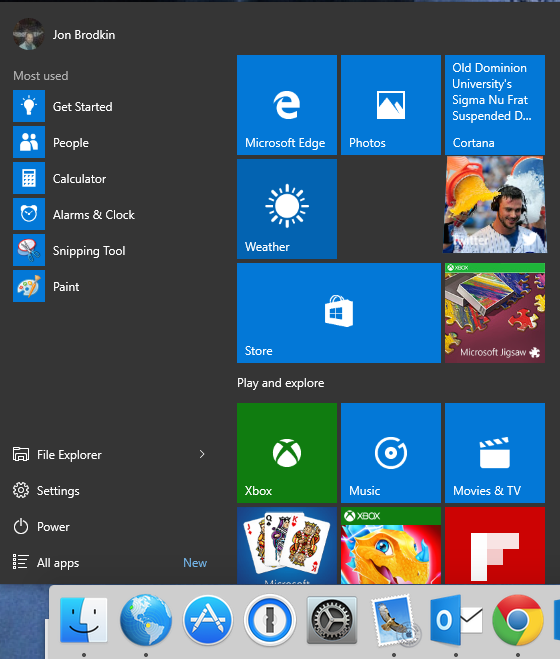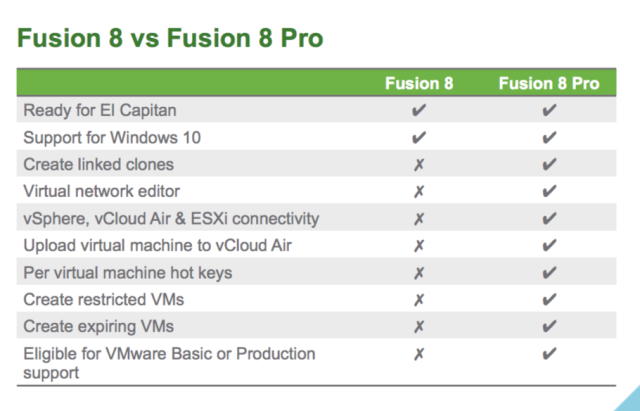VMware’s desktop virtualization software for Macs, Windows PCs, and Linux are being upgraded today to support Windows 10 and new features to boost performance.
VMware Fusion for Macs is up to version 8, while Workstation for Windows and Linux is up to version 12. Both products have an improved graphics engine to support DirectX 10 and OpenGL 3.3.
VMware's release comes one week after Parallels upgraded its desktop virtualization software for Macs. Here's what Fusion 8 looks like:
-
When it works right, Fusion 8 will let you access the Windows 10 Start menu for Mac.VMware
-
Windows 10 running on OS X El Capitan.
-
Launching the Edge Browser in Fusion's Unity Mode.VMware
-
Many virtual machines!VMware
-
Microsoft Office applications in Windows 10 on a Mac.VMware
-
Microsoft Office applications in Unity view on a Mac.VMware
-
Running Ubuntu, OS X, and Windows 10.VMware
-
Using Microsoft's Cortana virtual assistant.VMware
-
Ubuntu on a Mac, and the Fusion Virtual Machine Library.VMware
-
Using Fusion 8 Pro to connect to remote virtual machines through vSphere.VMware
-
Uploading a virtual machine from Fusion 8 Pro to a server.VMware
Upgrading to Fusion 8 right away might not be wise. VMware provided the software to Ars, and we came across a bug shortly after firing it up. The bug in some cases causes the Windows Start screen to be unavailable when running Windows 10 in Unity mode, which runs Windows applications alongside Mac ones. You can see the problem here, with the "Toggle Start Screen" option being grayed out:
VMware confirmed the bug to us yesterday and said it will not be fixed in the initial version going out to customers today. It will be fixed in a point release later on.
The bug isn't always present. On a second Windows 10 virtual machine, we were able to open the Start Screen—but the Start Screen's search bar was covered by the Mac's dock, so this wasn't perfect either:

In any case, it may be easier to open Windows applications using the VMware menu pictured above, which is accessible via the Fusion icon on the Mac's Menu Bar.As we reported last week, the year-old versions of VMware Fusion and Parallels Desktop won’t be updated to support Windows 10 in their Unity and Coherence modes, respectively. These modes let users run Windows applications on Macs in their own windows, separating them from the rest of Microsoft’s operating system. The year-old versions will run the whole Windows 10 OS in a single window, but without any fancy integration.
VMware’s Unity Mode for Windows 10 and other new features require paying for an upgrade.
Pricing
Fusion 8 costs $79.99, but Fusion 6 or 7 users can upgrade for $49.99.
There’s also Fusion 8 Pro for developers, IT pros, and other power users, which costs $199.99. Upgrades to Fusion 8 Pro are $119.99 from both the regular and Pro editions of Fusion 6 or 7. Customers switching from Parallels get 40 percent off either Fusion 8 or 8 Pro.
A buyer of VMware Fusion or Fusion Pro can install and use the software on multiple Macs as long as it's for personal, non-commercial use, according to VMware documentation (see page 42). Commercial use requires one license for each device. (Correction: This story originally described the licensing terms incorrectly. Thanks to reader Jonathon pointing out the exact licensing terms.)
Workstation 12 for Windows and Linux comes in two editions, Player and Pro. Workstation 12 Pro costs $249.99, or $149.99 to upgrade from version 10 or 11. Workstation requires one license per computer.
Workstation Pro was previously just called “Workstation.” It’s getting the name change because the lighter-weight Player software is now coming under the flagship Workstation brand. Last year’s VMware Player 7 Pro is thus being moved up a few version numbers, with the new upgrade called Workstation 12 Player.
Workstation 12 Player is free for personal use, but commercial use requires a license that costs $149.99. Upgrading from Player 6 or 7 costs $79.99.
Anyone who bought Fusion 7 or Workstation 11 on or after July 29 can upgrade for free.
Here's what Workstation 12 and Player look like:
-
Putting DirectX 10 to the test on Power Map for Excel in Workstation 12 Pro.VMware
-
A Windows 10 guest operating system on Workstation 12 Pro.VMware
-
Creating new virtual machines.VMware
-
Testing OpenGL 3.3 on Windows 8 in Workstation 12 Pro.VMware
-
As in last year's version, Workstation has multi-touch and pen support for the Surface Pro 3 and similar devices.VMware
-
Power Map on Workstation Player.VMware
-
Windows 10 on Workstation 12 Player.VMware
-
So many VMs!VMware
-
Creating a new virtual machine in Player.VMware
Fusion gets Cortana, DirectX 10
Fusion 8 is optimized for Windows 10 and is ready for the next version of OS X, El Capitan, as either a host or a guest operating system. As in previous editions, Fusion supports many Linux-based operating systems.
Windows 10 support includes integration with Microsoft's Cortana virtual assistant. Even in Unity mode, Cortana will remain active.
For performance improvements, Fusion 8 provides “up to 65 percent faster graphics with DirectX 10 and OpenGL 3.3 support,” according to VMware. Support for DirectX 10 means that certain applications work on Fusion for the first time, including Microsoft Power Map for Excel, a data visualization tool that doesn't work with DirectX 9.
Parallels has had official DirectX 10 support since 2013.
Fusion's virtual machine limits are unchanged from last year, at 16 virtual CPUs, 64GB of RAM, 8TB storage, and 2GB of video memory.
Fusion 8 is further optimized for newer hardware including the 5K Retina iMac, along with “enhanced resolution handling with multiple displays.” This means you can move a VM from one monitor to another and it will do a better job adjusting to different resolutions. There are also audio improvements for Skype and Lync VoIP calls.
Fusion 8 Pro is designed for developers, featuring integration with software like Docker, Chef, VMware's Project Photon, and Vagrant. A new feature this year is support for IPv6 including IPv6-to-IPv6 NAT (Network Address Translation), boosting the ability to create complex virtual networks.
Fusion 7 Pro last year added the ability to connect to virtual machines running in remote data centers on VMware's vSphere or ESXi software. Fusion 8 Pro adds a connection to VMware’s vCloud Air platform, which is similar to Amazon Web Services and Microsoft Azure but runs on VMware virtualization software. Users can upload and download virtual machines to remote data centers or VMware's cloud service or create virtual machines remotely. Fusion 8 Pro comes with $600 of vCloud Air credits that can be used for up to six months.

Workstation and Player keep pace
Workstation for Windows and Linux is the product that VMware launched with in 1999. Like Fusion Pro, it is targeted at an audience with higher technical requirements, such as developers and software engineers.
Workstation 12 Pro supports virtual machines with the same CPU, RAM, and disk sizes as Fusion 8. It includes the same enhancements for DirectX 10, OpenGL 3.3, and IPv6. It's also been upgraded to support the newest hardware and high-resolution displays. It supports Windows 10 in Unity mode, though that's less likely to be necessary since Workstation users may already be running on Windows 10.
Workstation already supported connections to vSphere, ESXi, and vCloud Air before this year, but the new Workstation Pro comes with the same $600 vCloud Air credit as Fusion 8 Pro.

Though Workstation Player has fewer features than Pro, they operate hand in hand. In business settings, Workstation Player is appropriate for a user device that has to run a particular virtual machine with specific security restrictions, while Workstation Pro can create those restricted virtual machines and use all the advanced features traditionally available in Workstation.
reader comments
44